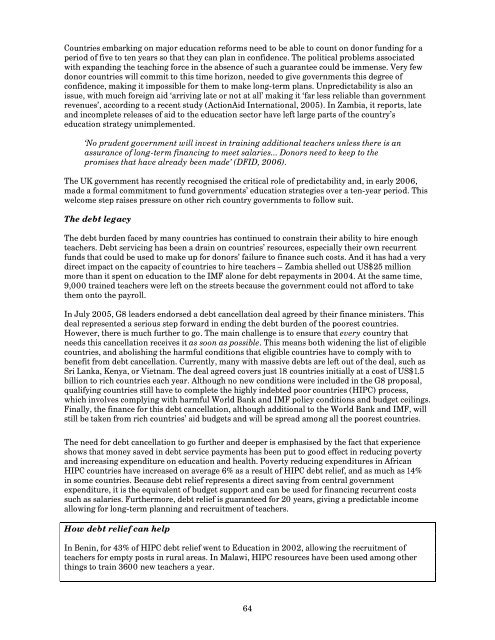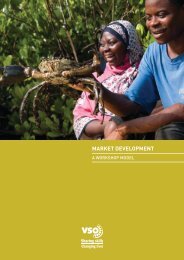Teachers for All â GCE policy briefing (566KB) - VSO
Teachers for All â GCE policy briefing (566KB) - VSO
Teachers for All â GCE policy briefing (566KB) - VSO
Create successful ePaper yourself
Turn your PDF publications into a flip-book with our unique Google optimized e-Paper software.
Countries embarking on major education re<strong>for</strong>ms need to be able to count on donor funding <strong>for</strong> aperiod of five to ten years so that they can plan in confidence. The political problems associatedwith expanding the teaching <strong>for</strong>ce in the absence of such a guarantee could be immense. Very fewdonor countries will commit to this time horizon, needed to give governments this degree ofconfidence, making it impossible <strong>for</strong> them to make long-term plans. Unpredictability is also anissue, with much <strong>for</strong>eign aid ‘arriving late or not at all’ making it ‘far less reliable than governmentrevenues’, according to a recent study (ActionAid International, 2005). In Zambia, it reports, lateand incomplete releases of aid to the education sector have left large parts of the country’seducation strategy unimplemented.‘No prudent government will invest in training additional teachers unless there is anassurance of long-term financing to meet salaries... Donors need to keep to thepromises that have already been made’ (DFID, 2006).The UK government has recently recognised the critical role of predictability and, in early 2006,made a <strong>for</strong>mal commitment to fund governments’ education strategies over a ten-year period. Thiswelcome step raises pressure on other rich country governments to follow suit.The debt legacyThe debt burden faced by many countries has continued to constrain their ability to hire enoughteachers. Debt servicing has been a drain on countries’ resources, especially their own recurrentfunds that could be used to make up <strong>for</strong> donors’ failure to finance such costs. And it has had a verydirect impact on the capacity of countries to hire teachers – Zambia shelled out US$25 millionmore than it spent on education to the IMF alone <strong>for</strong> debt repayments in 2004. At the same time,9,000 trained teachers were left on the streets because the government could not af<strong>for</strong>d to takethem onto the payroll.In July 2005, G8 leaders endorsed a debt cancellation deal agreed by their finance ministers. Thisdeal represented a serious step <strong>for</strong>ward in ending the debt burden of the poorest countries.However, there is much further to go. The main challenge is to ensure that every country thatneeds this cancellation receives it as soon as possible. This means both widening the list of eligiblecountries, and abolishing the harmful conditions that eligible countries have to comply with tobenefit from debt cancellation. Currently, many with massive debts are left out of the deal, such asSri Lanka, Kenya, or Vietnam. The deal agreed covers just 18 countries initially at a cost of US$1.5billion to rich countries each year. Although no new conditions were included in the G8 proposal,qualifying countries still have to complete the highly indebted poor countries (HIPC) process,which involves complying with harmful World Bank and IMF <strong>policy</strong> conditions and budget ceilings.Finally, the finance <strong>for</strong> this debt cancellation, although additional to the World Bank and IMF, willstill be taken from rich countries’ aid budgets and will be spread among all the poorest countries.The need <strong>for</strong> debt cancellation to go further and deeper is emphasised by the fact that experienceshows that money saved in debt service payments has been put to good effect in reducing povertyand increasing expenditure on education and health. Poverty reducing expenditures in AfricanHIPC countries have increased on average 6% as a result of HIPC debt relief, and as much as 14%in some countries. Because debt relief represents a direct saving from central governmentexpenditure, it is the equivalent of budget support and can be used <strong>for</strong> financing recurrent costssuch as salaries. Furthermore, debt relief is guaranteed <strong>for</strong> 20 years, giving a predictable incomeallowing <strong>for</strong> long-term planning and recruitment of teachers.How debt relief can helpIn Benin, <strong>for</strong> 43% of HIPC debt relief went to Education in 2002, allowing the recruitment ofteachers <strong>for</strong> empty posts in rural areas. In Malawi, HIPC resources have been used among otherthings to train 3600 new teachers a year.64
















